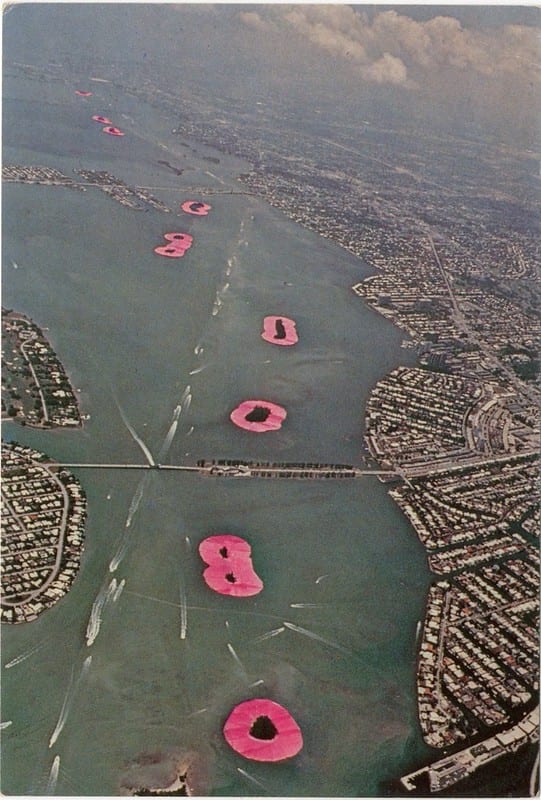
Since the 1960s, one form of art is consistently debated for its ethics. This form of art goes by many names, including “land art,” “earth art,” and “earthworks,” and includes the use of the environment to make an artistic point. Many of these artworks are about the relationship between humans and the natural environment, including the harm we often do to our planet. While many deem this form of art as a “necessary evil,” others believe that the harm to the environment caused by earthworks cannot be justified by the intention to spread awareness to a cause, however laudable. Perhaps the most infamous artist in this genre goes by the name Christo. This Bulgarian artist’s works include building fabric walls, surrounding islands with floating polypropylene sheets, and wrapping trees in opaque material. These works have not only sparked ethical debates but environmental and legal ones as well.
The controversies surrounding the work of Christo and his late wife Jeanne-Claude began with a piece in 1976 on farmland in California. After building 24 miles of 18-foot-high fabric walls, Christo was made to pay $60,000 in fines for failing to obtain the proper permits. In 1983, Christo surrounded 11 islands with floating pink woven polypropylene fabric, which lead to an outcry among wildlife groups and environmentalists and yet another legal battle over the environmental harm that the sun-blocking material could do to the marine ecosystem surrounding the islands. In 1991, “The Umbrellas” even ended in tragedy when a “485-pound yellow umbrella, part of an international project of the environmental artist Christo, was toppled by wind on Saturday, killing a woman… and injuring several other people.” (“Christo Umbrella,” 1991). Recently, Christo has canceled “Over the River,” an artwork he had been planning for over 20 years, which would drape 6 miles of the Arkansas River with a silvery cloth. While the large-scale earthwork would have enhanced tourism in this region, environmental critics worried about what the introduction of such artificial materials might have done to the river and canyon ecosystem (Worthington, 2017). Throughout his career, Christo has repeatedly pushed legal and environmental boundaries in pursuit of making his unique artworks, making him a leader of the earthwork or land art movement.
While some argue that the legal and environmental flaws of land art are enough to condemn it as unethical, others argue that the intention behind a work of art can either negatively or positively affect the ethics. A frequent occurrence in art is the usage of traditionally offensive symbols being used in art pieces to spread awareness or call for change. Although the pieces could be viewed as unethical by those who do not know the history behind the piece, many argue that an artist’s intention for good far outweighs the misinterpretation and harm it has the potential to create. In a way, this argument is similar to the idea of using land art to bring attention to environmental pieces. Many land artists, such as Martin Hill, seek to highlight the environment and promote ethical environmental practices using their work. On Hill’s website, he states “Changing to a new model of progress that does not destroy the living world on which life relies, requires us to use a new way of thinking. I believe art can help trigger this change.” This is a view that a very common in the land art community; many would see the relatively minor degradation and disruption caused by earthworks to be a small price to pay to shock or alert the public to environmental harm that our ways of life create. Others believe that regardless of the intention and goals, the harm to the environment integral to the creation of earthworks cannot be overlooked, and that there are other ways to highlight a cause without their artworks becoming a cause of the environmental damage or neglect that they criticize. Some earthwork artists might strive to exempt art altogether from solving—or continuing—practices of environmental degradation. Might an earthwork help us in more ways than what it does to a specific part of nature, an artist striving to give us a new way of seeing the world might ask? Good art should be judged by its form and creativity, perhaps, and not by its effects on the environment.
In response to the critics, many artists would say that art is supposed to be controversial and that the outcries and subsequent legal drama are merely a sign that the artwork has struck a chord with those whom it aims to affect. Christo insists that good art is supposed to be discussed and argued about, stating that “this is the only thing artists like to have, whether it’s painting or sculpture, to have the people comment and discuss their works” (Blevins, 2013). While many have criticized Christo for his usage of land art, many others praise him for his contribution to the art and architectural communities. Balasz Takac argues that the pieces of Christo have “not only intrigued and inspired the movements such as Land Art, but they have also moved architectural circles in terms of articulation of the domains of spatiality and the use of public space” (Takac, 2018).
Although the debate of earth art has been ongoing for decades, there seems to be no consensus in terms of what makes this form of art ethical or unethical. Some argue that the intention of the work is what makes something ethical. In this fashion, intentions to help focus attention on the environment, or to cause controversy and reflection, through a disruptive artwork assume prominence. Others, however, believe that the legal violations and damage to the environment insist otherwise. The question remains: How far can artists go in using the environment as an integral part of their artworks?
Discussion Questions:
- Why might artists feel that they need to use the environment in their works, instead of other ways of creating artworks?
- What values might conflict when artists use the environment in their works?
- How do you make sense of the intersection between artistic quality of an earthwork and its ethics—whether that sort of work ought to have been made in that way?
- What are the ethical concerns, and possible limits, of artists that need to degrade some part of the environment to make an artistic point about our relationship to nature? What if their aim is to shock us to treat nature better in our future actions?
- How does the intention or meaning of an artwork relate to its ethical value? Can something that is intensely meaningful or well-intentioned be unethical?
Further Information:
“Christo Umbrella Crushes Woman.” The New York Times, October 28, 1991. Available at: https://www.nytimes.com/1991/10/28/us/christo-umbrella-crushes-woman.html
Blevins, Jason, “Christo says opposition to “Over the River” project is part of the art.” Denver Post, October 17, 2013. Available at: https://www.denverpost.com/2017/01/25/christo-over-the-river-project-halted/
Takac, Balasz, “The Story Behind Christo and Jeanne-Claude’s Iconic Surrounded Islands Project in Miami.” Widewalls, September 28, 2018. Available at: https://www.widewalls.ch/christo-and-jeanne-claude-surrounded-islands-perez-art-museum/
“Christo’s controversial art: A timeline of irritating people with fabric.” The Week, September 14, 2010. Available at: https://theweek.com/articles/491115/christos-controversial-art-timeline-irritating-people-fabric
Worthington, Danika, “Christo pulls plug on controversial ‘Over The River’ public art installation, citing new ‘landlord’ Trump,” The Denver Post, January 25, 2017. Available at: https://www.denverpost.com/2017/01/25/christo-over-the-river-project-halted/
Authors:
Draven Schoberg & Scott R. Stroud, Ph.D.
Media Ethics Initiative
Center for Media Engagement
University of Texas at Austin
March 29, 2020
Image: Josephbergen / CC BY-NC-ND 2.0 / Modified
This case study can be used in unmodified PDF form for classroom or educational settings. For use in publications such as textbooks, readers, and other works, please contact the Center for Media Engagement.
Ethics Case Study © 2020 by Center for Media Engagement is licensed under CC BY-NC-SA 4.0



